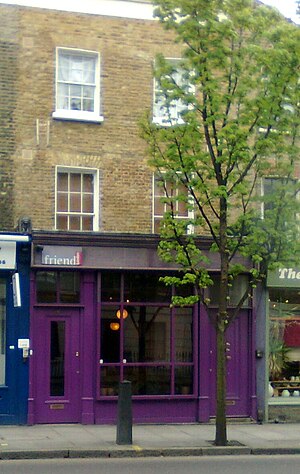London Friend
History
London Friend was set up in London in 1971 as a CHE taskforce intended to become CHE's counselling arm. The name was initially shown as FRIEND, intended as an acronym for "Fellowship for the Relief of the Isolated and Emotionally in Need and Distress."[1]
CHE was campaigning for equality but members soon recognised that there was a need for a telephone helpline and social support groups to help those who were isolated and coming out. They took referrals from the CHE headquarters in Manchester and the Manchester University Homophile Society. By the end of the year Friend had become a separate national counselling and befriending organisation. As the London-based organisation began to spread across the UK, and local groups grew up, the whole network began to be known as National Friend. It was incorporated as a limited company in 1987 with the name of National Friend Ltd.
A national network of volunteers soon evolved and at its peak Friend had 25 groups around the UK and Ireland [2].. National Friend set out guidelines for the operation of the local groups and monitored standards. Each group was an independent body with its own patrons and support groups and offered a range of services appropriate to the needs of its local community.
Mike Launder, a social worker activist within CHE, led the formation of London Friend, which at first operated from the Earls Court flat of one of the founders. But it was soon receiving so many letters and phone calls that it moved to a community centre in Church Street, Westminster. The Chair of London Friend, Jack Babuscio, a New Yorker who had witnessed the Stonewall Riots, published a book in 1976, We Speak for Ourselves, which stressed the need for social services and counselling organisations to be more aware of the presence – then often hidden – of gay people and our needs.
London Friend was separated from CHE in 1975. That year Friend was awarded an Urban Aid Grant of £7,900 sponsored by the London Borough of Islington. The grant was paid 75% by the Home Office and 25% by Islington Council. The grant enabled Friend to move into 274 Upper Street, Islington and appoint full time staff [3]
National Friend became a network of groups whose volunteers provided information, support and befriending to lesbians, gay men and bisexual people. Local groups were affiliated to National Friend, though they remained autonomous within agreed guidelines, which included a constitution, code of ethics, code of practice, an equal opportunities programme and a complaints procedure.
In 1995 there were 31 local groups calling themselves either Friend or Gay Switchboard.
The National Committee supported the local groups, provides guidance, advertises the work of Friend to outside agencies and holds conferences on subjects of mutual interest.
In 1998, a grant from the National Lottery Charities Board enabled the development of a permanent office in Birmingham where two members of staff deal with administration, publicity and fundraising.
National Friend ceased to exist in 2003.[4]
London Friend today
London Friend is now the oldest UK LGBT charity.
Current services include:
- LGB&T counselling
- Training for healthcare professionals
- Drug and alcohol support
- LGB&T helpline
- Social and support groups
- Coming out groups
- Volunteering opportunities
- A selection of LGB&T books, magazines and information.[5]
The Chief Executive of London Friend is Monty Moncrieff.[6] He succeeded Matthew Halliday in 2012.
Women at London Friend
While the majority (approximately two thirds) of volunteers, staff and service users at London Friend have been men, women have contributed very significantly to the organisation. There have been at least one woman Chair of the Management Committee and two Company Secretaries. Some of the paid staff have also been women.
There was a women’s helpline which ran alongside the main helpline. The women’s coming out group, Changes, has been meeting at London Friend since the 1980s or earlier. Many women will remember LAFS, a social group which large numbers of women attended, which eventually ceased meeting and was followed by another group, NextStep. Janet Chambers, who was a paid member of staff, together with women from the Greater London Council, set up the Older Lesbian Network, which originally met at London Friend. In the 1980s there was a black women’s group called Onyx at London Friend, which was very popular. And the Lesbian AA (Alcoholics Anonymous) group, the only one of its kind in Europe, met at London Friend for twenty years or so.
External links
http://www.londonfriend.org.uk/ London Friend website
References
Including material from the history page on the London Friend website.
- ↑ Amiable Warriors, Volume One, page 379 footnote.
- ↑ 'Introducing Friend in London' booklet (1976). LSE HCA/Albany Trust/16/12
- ↑ LSE HCA/Albany Trust/16/12
- ↑ http://www.charity-commission.gov.uk/ShowCharity/RegisterOfCharities/RemovedCharityMain.aspx?RegisteredCharityNumber=296300&SubsidiaryNumber=0
- ↑ http://londonfriend.org.uk/about/
- ↑ http://londonfriend.org.uk/professionals/training/our-trainers/
